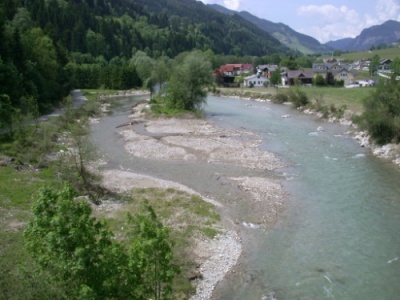Lower river banks or floodplains to enlarge inundation and flooding
Contents
- 1 General description
- 2 Applicability
- 3 Expected effect of measure on (including literature citations)
- 4 Temporal and spatial response
- 5 Pressures that can be addressed by this measure
- 6 Cost-efficiency
- 7 Case studies where this measure has been applied
- 8 Useful references
- 9 Other relevant information
General description
Flooding of wetlands is vital for maintaining the health of many riparian ecosystems. Periodic flooding controls the plant community by disturbance favouring pioneer species (Azami et al. 2004). Goals of restoration are the inundation of areas to provide habitat for different species (vegetation, fish, amphibians, birds) and the rehabilitation of degraded wetlands. Additionally, these projects can lead to improvements in physical, hydrological and other natural processes (Roni et al. 2005). Many of the eco-hydrological functions of floodplains are strongly related to the interactions between the floodplains shallow groundwater and the surface water of the usually well connected lowland rivers (Hancock et al. 2005). The reconnection of isolated floodplain habitats by lowering river embankments is a common technique and studies have shown its effectiveness at providing habitat for salmonid and nonsalmonid fishes (Grift et al. 2001, Morley et al. 2005).
Applicability
Lowering the embankments enables lateral connectivity and offers a way to allow backwaters habitats to be passively revitalized by restoring hydrological pathways (Ayres et al. 2014). Allowing even small sectors of the floodplain to be restored encourages inundation and can re-instate scour, erosion, and deposition by flow and sediment pulses (Sparks 1995). The formation of hydric soils and the colonization of new habitats via seed banks and dispersal routes consequently follow the restoration as part of the natural recovery process (Ayres et al. 2014).
Expected effect of measure on (including literature citations)
| Category | Description | Source (citation) |
| HYMO | Increase of shallow water habitats | Muhar et al. 2008 |
| Macrophytes | ||
| Macroinvertebrats | ||
| Fish | Reconnecting floodplains can lead to increases in fisheries yield, Juvenile stages of key fish species benefit from increased shallow habitats | Payne and Cowan 1998; Muhar et al. 2008 |
Temporal and spatial response
Pressures that can be addressed by this measure
- Channelisation / cross section alteration
- Embankments, levees or dikes
- Alteration of instream habitat
Cost-efficiency
Case studies where this measure has been applied
- Gameren
- Lahn Cölbe
- Renaturierung Untere Havel
- Vääräjoki - Niskakoski
- Kuivajoki - Hirvaskoski
- Millingerwaard - Floodplain rehabilitation
- Regge Velderberg
- Meers - Floodplain lowering
- Opijnen - Side Channel
- Vreugderijkerwaard - Side channel
- Rijkelse Bemden - River bed widening
- Thur
- Uilenkamp - Meander reconnection
- Bouxweerd - Artificial pool
- Töss
- River Roding at Ray Lodge Park
- River Skerne EU-LIFE project
- Beneden-Leeuwen - Side channel
- Drava - Kleblach
- Enns - Aich
- Buiten Ooij - Sluice operation
- Hondsbroeksche Pleij – Restoring former floodplains (INTERREG Sustainable Development of Floodplains)
- Bemmelse Waard – Restoring former floodplains (INTERREG Sustainable Development of Floodplains)
- Blashford - Demonstrating strategic restoration and management STREAM (LIFE05 NAT/UK/000143)
- Niederwerrieser Weg - Optimisation of the pSCI “Lippe floodplain between Hamm and Hangfort” (LIFE05/NAT/D/000057)
- Oberwerries - Optimisation of the pSCI “Lippe floodplain between Hamm and Hangfort” (LIFE05/NAT/D/000057)
- Ahlen-Dolberg - Optimisation of the pSCI “Lippe floodplain between Hamm and Hangfort” (LIFE05/NAT/D/000057)
- Soest - Optimisation of the pSCI “Lippe floodplain between Hamm and Hangfort” (LIFE05/NAT/D/000057)
- IJssel
- River Rhine - IJsseluiterwaarden Olst
- Scheldt - Vallei Grote Nete
- Rhine - Meinerswijk
- Drava - River Widening Amlach/St. Peter
- Drava - River Widening Obergottesfeld
- Rhine - Ontpoldering Noordwaard
- Lower Traun
- Lippeaue Klostermersch
- Ruhr Binnerfeld
Useful references
- Ayres, A., H. Gerdes, B. Goeller, M. Lago, M. Catalinas, Á. García Cantón, R. Brouwer, O. Sheremet, J. Vermaat, N. Angelopoulos, and I. Cowx (2014). Inventory of restoration costs and benefits. REFORM Deliverable 1.4.
- Azami, K., H. Suzuki, and S. Toki (2004). Changes in riparian vegetation communities below a large dam in a monsoonal region: Futase Dam, Japan. River Research and Applications, 20 (5), 549–563.
- Grift, R. E., A. D. Buijse, W. L. T. van Densen, and J. G. Klein (2001). Restoration of river-floodplain interaction: benefits for the fish community in the river Rhine. Archiv für Hydrobiologie, 135, 2-4.
- Hancock, P. J., A. J. Boulton, and W.F. Humphreys (2005). Aquifers and hyporheic zones: towards an ecological understanding of groundwater. Hydrogeology Journal, 13, 98–111.
- Morley, S. A., P. S. Garcia, T. R. Bennett, and P. Roni. (2005). Juvenile salmonid (Oncorhynchus spp.) use of constructed and natural side channels in Pacific Northwest rivers. Canadian Journal of Fisheries and Aquatic Sciences, 62, 2811–2821.
- Muhar, S., M. Jungwirth, G. Unfer, C. Wiesner, M. Poppe, S. Schmutz, S. Hohensinner, and H. Habersack (2008). Restoring riverine landscapes at the Drau River: successes and deficits in the context of ecological integrity. Gravel-Bed Rivers VI: From Process Understanding to River Restoration H. Habersack, H. Pie´gay, M. Rinaldi, Editors 779-803.
- Payne, A. I., and V. Cowan (1998). Review of stock enhancement in the floodplains of Bangladesh. FAO (Food and Agriculture Organization of the United Nations) Fisheries Biology Technical Paper 374.
- Roni, P., K. Hanson, T. Beechie, G. Pess, M. Pollock, and D. M. Bartley (2005). Habitat rehabilitation for inland fisheries. Global review of effectiveness and guidance for rehabilitation of freshwater ecosystems. FAO Fisheries Technical Paper, 484.
- Sparks, R. E. (1995). Need for ecosystem management of large rivers and their floodplains. Bioscience, 45, 168–182.
